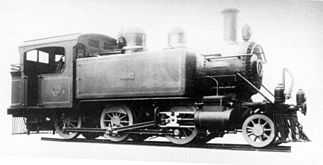CGR 3rd Class 2-6-0T
| CGR 3rd Class 2-6-0T to South African Class 03 2-6-0T | |
|---|---|
|
3rd Class 2-6-0T no. 50 J.S. Smit, ex Indwe Collieries | |
| Type and origin | |
| Power type | Steam |
| Designer | Dickson Manufacturing Company |
| Builder | Dickson Manufacturing Company |
| Serial number | 1079-1082 |
| Build date | 1899 |
| Total produced | 4 |
| Specifications | |
| Configuration | 2-6-0T "Mogul" |
| Gauge | 3 ft 6 in (1,067 mm) Cape gauge |
| Driver diameter | 44 in (1,120 mm) |
| Fuel type | Coal |
| Cylinders | Two |
| Cylinder size |
14 in (356 mm) bore 20 in (508 mm) stroke |
| Career | |
| Operator(s) |
Indwe Collieries Cape Government Railways South African Railways |
| Class | CGR 1st Class, SAR Class 01 |
| Number in class | 4 |
| Number(s) | Indwe 1-4, CGR 50-53, SAR 050-053 |
| Official name | J.S. Smit, J.J. Spier, L.S. Meyer, C. Birkenstock |
| Delivered | 1900 |
| First run | 1900 [1][2] |
The Cape Government Railways 3rd Class 2-6-0T of 1900 was a South African steam locomotive from the pre-Union era in the Cape Colony.
In 1900, during the South African War, four 2-6-0 tank locomotives that were destined for the Nederlandsche-Zuid-Afrikaansche Spoorweg-Maatschappij in the Zuid-Afrikaansche Republiek were intercepted by the Imperial Military Railways and diverted to Indwe Collieries. When the Cape Government Railways took over the operation of the colliery line and the locomotives after the war, they were designated 3rd Class and when the South African Railways was established, they were designated Class 03.[1][2]
Manufacturer
Before the outbreak of the South African War in October 1899, four tank locomotives were ordered by the Nederlandsche-Zuid-Afrikaansche Spoorweg-Maatschappij (NZASM) in the Zuid-Afrikaansche Republiek (ZAR) from Dickson Manufacturing Company in Scranton, Pennsylvania, through the agency of Arthur Koppel. However, when they were landed in the Cape Colony in 1900, they were commandeered by the Imperial Military Railways (IMR) and allocated to Indwe Collieries.[1][2]
The locomotives bore plates inscribed "SS ZAR" for "Staats-Spoorwegen Zuid-Afrikaansche Republiek" and were named J.S. Smit, J.J. Spier, L.S. Meyer and C. Birkenstock, all personalities of note in the ZAR. Indwe Collieries numbered them in the range from 1 to 4.[1][2]
Service
Indwe Collieries
Indwe Collieries, located in the northeastern part of the Cape Colony, owned the branchline from Sterkstroom via Dordrecht to the collieries and supplied coal to the Cape Government Railways (CGR). The branchline had been constructed for the collieries by George Pauling in 1896.[1][2]
Cape Government Railways
After the war, the colliery line and the locomotives were purchased by the CGR. The locomotives were designated the CGR 3rd Class and were renumbered in the range from 50 to 53.[1][2][3]
South African Railways
The Union of South Africa was established on 31 May 1910, in terms of the South Africa Act. One of the clauses in the Act required that the three Colonial Government railways, the CGR, the Natal Government Railways and the Central South African Railways, also be united under one single administration to control and administer the railways, ports and harbours of the Union. While the South African Railways (SAR) came into existence in 1910, the actual classification and renumbering of all the rolling stock of the three constituent railways required careful planning and was only implemented with effect from 1 January 1912.[3][4]
All four locomotives were still in service in 1912. The SAR considered them obsolete and they were designated Class 03 and renumbered by having the numeral 0 prefixed to their existing numbers. They were withdrawn from service in 1915.[1][2]
Works numbers
The works numbers, names and renumberings of the CGR 3rd Class Mogul tank locomotives are set out in the table.[2][4]
Works no. |
Name | Indwe no. |
CGR no. |
SAR no. |
|---|---|---|---|---|
| 1079 | J.S. Smit | 1 | 50 | 050 |
| 1080 | J.J. Spier | 2 | 51 | 051 |
| 1081 | L.S. Meyer | 3 | 52 | 052 |
| 1082 | C. Birkenstock | 4 | 53 | 053 |
See also
References
|
- ↑ 1.0 1.1 1.2 1.3 1.4 1.5 1.6 Paxton, Leith; Bourne, David (1985). Locomotives of the South African Railways (1st ed.). Cape Town: Struik. pp. 18–19. ISBN 0869772112.
- ↑ 2.0 2.1 2.2 2.3 2.4 2.5 2.6 2.7 Holland, D.F. (1971). Steam Locomotives of the South African Railways, Volume 1: 1859-1910 (1st ed.). Newton Abbott, Devon: David & Charles. p. 83. ISBN 978-0-7153-5382-0.
- ↑ 3.0 3.1 The South African Railways - Historical Survey. Editor George Hart, Publisher Bill Hart, Sponsored by Dorbyl Ltd., Published c. 1978, pp. 12, 25.
- ↑ 4.0 4.1 Classification of S.A.R. Engines with Renumbering Lists, issued by the Chief Mechanical Engineer’s Office, Pretoria, January 1912, p. 18. (Reprinted in April 1987 by SATS Museum, R.3125-6/9/11-1000)
